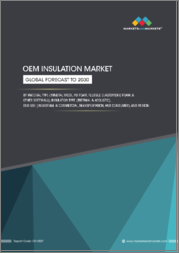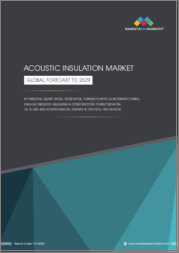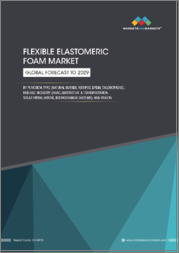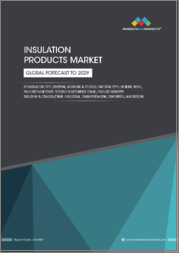
|
시장보고서
상품코드
1456935
세계의 엘라스토머 폼 시장 예측(2024-2029년)Elastomeric Foam Market - Forecasts from 2024 to 2029 |
||||||
엘라스토머 폼 시장은 2022년에는 33억 8,400만 달러로 평가되었고 복합 연간 성장률(CAGR) 6.33%로 성장할 전망이며 2029년에는 58억 9,100만 달러 규모에 이를 것으로 예측되고 있습니다.
합성 고무 화합물은 탄성중합체 폼을 구성하는 다목적 단열재로 뛰어난 내구성, 유연성 및 단열성으로 잘 알려져 있습니다. HVAC 시스템에서 널리 사용되며 고무 구조는 열 전달을 효율적으로 줄이고 적절한 온도를 유지하면서 다양한 표면과 구성에 적응하는 데 도움이 됩니다. 또한 습기와 수분에 강하기 때문에 부식과 곰팡이의 발생을 방지하고 결로로 인한 문제도 방지합니다.
또한, 엘라스토머 폼은 효과적인 흡음재이며, 소음 전달을 억제하여 HVAC 시스템의 차음성을 높입니다. 또한 외부로부터의 영향이나 자외선에도 강하기 때문에 오랜 신뢰성과 성능을 보장합니다.
시장 동향 :
끊임없이 변화하는 기상 조건, 공해, 오염 물질 및 습도는 엘라스토머 폼 시장의 성장을 가속합니다. 폐쇄형 셀 폼은 냉동 용도에도 적합합니다. 설치가 용이하고 내화성이 뛰어나 난방 및 급배수 산업에서 자주 이용되고 있습니다. 또한, 경량이기 때문에 건축 산업은 건물의 총 무게를 줄이는 데 사용됩니다. 친환경 제품의 개발은 현저한 동향입니다. 엘라스토머의 폐기 가능성과 제조 공정에서의 가스 배출에 관한 소비자의 지식은 환경 친화적이고 지속 가능한 단열재에 대한 수요를 상당히 증가시키고 있습니다.
또한, 프레온, HFC 및 기타 유해 가스는 생산 공정에서 단계적으로 제거됩니다. 새롭게 탄생한 친환경 엘라스토머 폼은 내구성이 뛰어나 고무 스폰지보다 40%도 경량으로 물을 흡수하지 않고 제조도 간단합니다. 이러한 요소는 엘라스토머 폼 시장에 영향을 미치고 있습니다.
시장 성장 촉진요인:
- 최종 용도 부문에서 HVAC 시스템 수요 증가.
HVAC(난방, 환기, 에어컨) 시스템에 대한 수요 증가는 탄성중합체 시장을 견인하는 주요 요인입니다. 인구 증가, 도시화, 산업화에 의해 건설되는 주택, 상업용 건물 및 산업용 건물이 증가함에 따라 효과적인 기후 제어 시스템이 필요합니다. 엘라스토머 폼은 뛰어난 단열 성능을 높게 평가하며, 에어 핸들링 유닛, 덕트, 파이프의 단열에 사용되는 HVAC 용도에 필수적입니다.
엘라스토머 폼의 요구는 환경 목표 및 법적 요구 사항에 부응하는 에너지 효율적인 HVAC 시스템의 사용 증가로 더욱 커지고 있습니다. 또한, HVAC 시스템의 성장은 건축 기술의 진보와 실내 공기의 질의 중시 증가에 의해 촉진되고 엘라스토머 형태 시장 수요를 지원합니다.
- 에너지 효율 규제는 시장에 긍정적인 영향을 미칠 수 있습니다.
에너지 효율에 관한 법률은 고성능 단열재 수요를 촉진하고 엘라스토머 폼 산업에 큰 영향을 미칩니다. 세계 각국의 정부가 온실가스 배출량을 줄이고 지속가능한 건축방법을 촉진하는 것을 목표로 하는 엄격한 에너지규제와 요건을 부과하고 있기 때문에 건물과 산업시설의 열효율을 개선 점점 더 중요 해지고 있습니다.
이러한 규제를 충족시키기 위해 열전도율이 낮고 내습성이 우수한 엘라스토머 폼이 선택되고 있습니다. 엘라스토머 폼은 파이프라인, 덕트, HVAC 시스템 및 기타 인프라 부품의 에너지 효율을 개선하기 위해 계약자, 건설업자, 시설 관리자에 의해 많이 사용됩니다.
건설 활동 증가는 엘라스토머 형태 시장의 활성화로 이어질 것으로 예상됩니다.
엘라스토머 폼 시장은 인프라 및 건축 프로젝트에서 단열재의 필요성을 부추기는 건설 활동 증가로 큰 영향을 받고 있습니다. 에너지 효율을 높이고 건축 요건을 준수하며 거주자의 편안함을 보장하기 위해 특히 신흥 경제국과 대도시 지역에서는 고성능 단열 솔루션에 대한 요구가 높아지고 있습니다.
또한 뛰어난 유연성, 내구성 및 단열성으로 인해 엘라스토머 폼은 다양한 건축 프로젝트의 용도로 선정되는 재료가 되었습니다. 파이프, 냉동 장치, HVAC 시스템, 건물 외벽(벽, 바닥, 지붕 등)의 단열에 널리 사용됩니다. 또한, 엘라스토머 폼은 에너지 사용량과 온실가스 배출량을 줄이기 때문에 지속가능한 건축기술을 중시하고 그 사용을 장려하고 있습니다.
시장 성장 억제요인:
- 일회용 가능성과 소비자 인식 부족은 시장 성장을 방해할 수 있습니다.
발포체는 클로로프렌, 부타디엔, 이소프렌, 아크릴로니트릴, 너도밤나무, 부틸 고무 등 다양한 엘라스토머로부터 제조됩니다. 시장 확대를 방해하는 문제 중 하나는 일회용입니다. 일부 엘라스토머는 태우면 독성 가스와 유해 가스를 발생시켜 불꽃이 흩어져 불쾌한 냄새가납니다. 게다가 재료과학의 기술개척에 접할 기회가 적기 때문에 엘라스토머 폼 대신 면, 천연 라텍스, 코어, 유기 울 등의 종래품이 사용되어 시장 수요가 감소할 것으로 예측됩니다.
아시아태평양이 엘라스토머 폼 시장에서 큰 점유율을 차지할 것으로 예측됩니다.
아시아태평양은 엘라스토머 폼 시장에서 가장 높은 점유율을 차지할 것으로 예측됩니다. 온도와 환기를 관리하는 HVAC 시스템에 대한 산업 부문의 높은 수요가 엘라스토머 폼 수요를 끌어올립니다. 단열은 가장 자주 사용되는 전략 중 하나이며 산업 활동에 필요한 적절한 환경을 유지하는 데 도움이되는 다양한 부문에서 사용됩니다. 예를 들어, 적절한 환기, 온도 제어 및 공기 청정은 화학물질 저장 및 생산 산업에서 근로자의 건강하고 안전한 직장을 확보하는 데 필요합니다. 이 지역에서의 HVAC 시스템 수요 증가는 산업 사업 및 저장 시설로부터 수요 증가에 의해 촉진될 것으로 예상됩니다.
중국, 인도, 기타 동남아시아 국가 등에서는 원재료의 입수가 용이하기 때문에 시장 성장이 촉진될 것으로 예측됩니다. 아시아태평양 국가의 낮은 인건비는 제조업체가 새로운 제조 시설과 사업부를 개발하는 큰 동기 중 하나가 될 것으로 예측됩니다.
시장 개척:
- 2022년 1월 일본 경제산업성에 따르면 유연한 탄성중합체 형태로 만들어진 단열재의 새로운 업계 표준이 발표되었습니다. JIS A9516 표준은 테일러드 폼의 주요 공급업체이며 장비 단열 부문을 위한 연질 폼의 세계 리더인 알마셀의 엄청난 협력을 통해 개발되었습니다.
- 2021년 7월, Aptar는 Weihai Hengyu Medical Products와 주사제 전달을 위한 엘라스토머 및 플라스틱 부품의 제조 능력을 중국에 추가하기로 합의했다고 발표했습니다.
목차
제1장 서론
- 시장 개요
- 시장의 정의
- 조사 범위
- 시장 세분화
- 통화
- 전제조건
- 기준년과 예측년의 타임라인
- 관계자에게 있어서의 주요 이점
제2장 조사 방법
- 조사 디자인
- 조사 과정
제3장 주요 요약
- 주요 조사 결과
- 애널리스트 보기
제4장 시장 역학
- 시장 성장 촉진요인
- 시장 성장 억제요인
- Porter's Five Forces 분석
- 업계 밸류체인 분석
- 애널리스트 보기
제5장 엘라스토머 폼 시장 : 유형별
- 소개
- 천연 고무/라텍스
- 에틸렌 프로파일렌 디엔 단량체(EPDM)
- 니트릴 부타디엔 고무(NBR)
제6장 엘라스토머 폼 시장 : 용도별
- 소개
- 에어컨
- 냉동
- 물용 파이프
- 액체가스
- 기타
제7장 엘라스토머 폼 시장 : 지역별
- 소개
- 북미
- 남미
- 유럽
- 중동 및 아프리카
- 아시아태평양
제8장 경쟁 환경과 분석
- 주요 기업과 전략 분석
- 시장 점유율 분석
- 합병, 인수, 합의 및 콜라보레이션
- 경쟁 대시보드
제9장 기업 프로파일
- Armacell Yalitim AS
- Zotefoams
- Kaimann(Saint-Gobain Group)
- Huamei Energy-Saving Technology Group Co. Ltd.
- Hira Industries LLC
- NMC Technical Insulation
- Rogers Foam Corporation
- K-Flex USA
- Aerofoam
The elastomeric foam market is evaluated at US$3.384 billion for the year 2022 and is projected to grow at a CAGR of 6.33% to reach a market size of US$5.891 billion by the year 2029.
Synthetic rubber compounds make up elastomeric foam, a multipurpose insulation material that is well-known for its remarkable durability, flexibility, and thermal insulation qualities. It is widely used in HVAC systems, and its rubbery structure helps it adapt to different surfaces and configurations while efficiently reducing heat transfer and maintaining appropriate temperatures. Its natural resistance to moisture and humidity defends against corrosion and mold growth in humid conditions, as well as preventing condensation-related problems.
Additionally, elastomeric foam is an effective sound absorber that improves HVAC systems' acoustic insulation by reducing noise transfer. Its resilience to external influences and UV rays guarantees years of dependability and performance.
MARKET TRENDS:
Constantly changing weather conditions, pollution, pollutants, and humidity drive the elastomeric foam market growth. Closed-cell foam is also best suited for refrigeration applications. It is frequently utilized in the heating and plumbing industries due to its ease of installation and fire-resistant characteristics. Furthermore, due to their lightweight, they are used in the construction industry to reduce total building weight. The development of environmentally friendly products is a prominent trend. Consumer knowledge of the disposability of elastomers and the emissions of gases during the production process has considerably raised the demand for eco-friendly and sustainable insulation.
In addition, CFCs, HFCs, and other hazardous gases have been phased out of the production process. The newly created environmentally friendly elastomeric foams are very durable, up to 40% lighter in weight than rubber sponges, do not absorb water, and are simply manufactured. These factors altogether impact the elastomeric foam market.
MARKET DRIVERS:
- Increased demand for HVAC systems from end-use sectors.
Growing demand for HVAC (heating, ventilation, and air conditioning) systems is a major factor driving the elastomeric foam market. Effective climate control systems are necessary for the increasing number of residential, commercial, and industrial buildings that are being built as a result of population growth, urbanization, and industrialization. Highly valued for its outstanding thermal insulation capabilities, elastomeric foam becomes essential in HVAC applications where it is used to insulate air handling units, ducts, and pipes.
The need for elastomeric foam is further increased by the growing use of energy-efficient HVAC systems, which is being pushed by environmental objectives and legal requirements. Furthermore, the growth of HVAC systems is driven by advances in building technology and the increased emphasis on indoor air quality, which sustains market demand for elastomeric foam.
- Energy efficiency regulations may positively impact the market.
Energy efficiency laws drive demand for high-performance insulation materials, which has a significant impact on the elastomeric foam industry. It is becoming more and more important to improve the thermal efficiency of buildings and industrial facilities as governments across the world impose strict energy regulations and requirements meant to lower greenhouse gas emissions and promote sustainable building practices.
To satisfy these regulations, elastomeric foam which is well-known for its remarkable insulating qualities, such as its low heat conductivity and moisture resistance emerges as a preferred option. Elastomeric foam is being used more by contractors, builders, and facility managers to improve the energy efficiency of pipelines, ducts, HVAC systems, and other infrastructure parts.
A rise in construction activities is anticipated to fuel the elastomeric foam market.
The elastomeric foam market is significantly impacted by the growth in construction activities, which fuels the need for insulating materials in infrastructure and building projects. To improve energy efficiency, adhere to building requirements, and guarantee occupant comfort, there is a growing need for high-performance insulation solutions, especially in rising economies and metropolitan regions.
Furthermore, owing to its exceptional flexibility, durability, and thermal insulation qualities, elastomeric foam has become the material of choice for many different building project applications. It is widely used to insulate pipes, refrigeration units, HVAC systems, and building envelopes, which include walls, floors, and roofs. Furthermore, as elastomeric foam lowers energy use and greenhouse gas emissions, the growing emphasis on sustainable construction techniques encourages its use.
MARKET RESTRAINTS:
- Disposability and lack of awareness among consumers may hinder the market growth.
Foams are produced from a variety of elastomers, including chloroprene, butadiene, isoprene, acrylonitrile, Buna N, butyl rubbers, and others. One of the problems impeding market expansion is disposability. When burned, a few elastomers emit poisonous and hazardous gases, have a sooty flame, and have an unpleasant odor. Furthermore, owing to a lack of exposure to technical developments in material science, the usage of conventional goods such as cotton, natural latex, coir, and organic wool instead of elastomeric foam is projected to reduce market demand.
Asia Pacific is predicted to account for a significant share of the elastomeric foam market.
Asia-Pacific is expected to have the highest elastomeric foam market share. The high demand for HVAC systems from the industrial sector to manage temperature and ventilation will drive up the demand for elastomeric foam. Thermal insulation is one of the most frequently utilized strategies and is used in a variety of sectors to assist in maintaining the correct environment required for industrial operations. Proper ventilation, temperature control, and air cleansing, for instance, are necessary for the chemical storage and production industries to ensure a healthy and safe workplace for workers. The rising demand for HVAC systems in this region is anticipated to be fuelled by the increasing demand from industrial businesses and storage facilities.
The ease of obtaining raw materials in countries such as China, India, and other Southeast Asian countries is projected to boost the market's growth. Low labor costs in various Asia-Pacific nations are anticipated to be one of the major motivators for manufacturers to develop new manufacturing facilities and business units.
Market Developments:
- In January 2022, a new industry standard for thermal insulation materials made of flexible elastomeric foam was released, according to Japan's Ministry of Economy, Trade and Industry. The JIS A9516 standard was developed with significant assistance from Armacell, a major supplier of tailored foams and a global leader in flexible foam for the equipment insulation sector.
- In July 2021, Aptar announced an agreement with Weihai Hengyu Medical Products to add elastomeric and plastic component manufacturing capabilities in China for injectable drug delivery.
Segmentation:
By Type
- Natural Rubber/Latex
- Ethylene Propylene Dien Monomer (EPDM)
- Nitrile Butadiene Rubber (NBR)
By Application
- Air Conditioning
- Refrigeration
- Water Pipes
- Liquid gasses
- Others
By Geography
- North America
- United States
- Canada
- Mexico
- South America
- Brazil
- Argentina
- Others
- Europe
- UK
- France
- Germany
- Italy
- Others
- Middle East and Africa
- Saudi Arabia
- UAE
- Others
- Asia Pacific
- Japan
- China
- India
- Thailand
- Taiwan
- Indonesia
- Others
TABLE OF CONTENTS
1. INTRODUCTION
- 1.1. Market Overview
- 1.2. Market Definition
- 1.3. Scope of the Study
- 1.4. Market Segmentation
- 1.5. Currency
- 1.6. Assumptions
- 1.7. Base, and Forecast Years Timeline
- 1.8. Key Benefits for the stakeholder
2. RESEARCH METHODOLOGY
- 2.1. Research Design
- 2.2. Research Processes
3. EXECUTIVE SUMMARY
- 3.1. Key Findings
- 3.2. Analyst View
4. MARKET DYNAMICS
- 4.1. Market Drivers
- 4.2. Market Restraints
- 4.3. Porter's Five Forces Analysis
- 4.3.1. Bargaining Power of Suppliers
- 4.3.2. Bargaining Power of Buyers
- 4.3.3. Threat of New Entrants
- 4.3.4. Threat of Substitutes
- 4.3.5. Competitive Rivalry in the Industry
- 4.4. Industry Value Chain Analysis
- 4.5. Analyst View
5. ELASTOMERIC FOAM MARKET, BY TYPE
- 5.1. Introduction
- 5.2. Natural Rubber/Latex
- 5.2.1. Market Trends and Opportunities
- 5.2.2. Growth Prospects
- 5.2.3. Geographic Lucrativeness
- 5.3. Ethylene Propylene Dien Monomer (EPDM)
- 5.3.1. Market Trends and Opportunities
- 5.3.2. Growth Prospects
- 5.3.3. Geographic Lucrativeness
- 5.4. Nitrile Butadiene Rubber (NBR)
- 5.4.1. Market Trends and Opportunities
- 5.4.2. Growth Prospects
- 5.4.3. Geographic Lucrativeness
6. ELASTOMERIC FOAM MARKET, BY APPLICATION
- 6.1. Introduction
- 6.2. Air Conditioning
- 6.2.1. Market Trends and Opportunities
- 6.2.2. Growth Prospects
- 6.2.3. Geographic Lucrativeness
- 6.3. Refrigeration
- 6.3.1. Market Trends and Opportunities
- 6.3.2. Growth Prospects
- 6.3.3. Geographic Lucrativeness
- 6.4. Water Pipes
- 6.4.1. Market Trends and Opportunities
- 6.4.2. Growth Prospects
- 6.4.3. Geographic Lucrativeness
- 6.5. Liquid Gasses
- 6.5.1. Market Trends and Opportunities
- 6.5.2. Growth Prospects
- 6.5.3. Geographic Lucrativeness
- 6.6. Others
- 6.6.1. Market Trends and Opportunities
- 6.6.2. Growth Prospects
- 6.6.3. Geographic Lucrativeness
7. ELASTOMERIC FOAM MARKET, BY GEOGRAPHY
- 7.1. Introduction
- 7.2. North America
- 7.2.1. By Type
- 7.2.2. By Application
- 7.2.3. By Country
- 7.2.3.1. United States
- 7.2.3.1.1. Market Trends and Opportunities
- 7.2.3.1.2. Growth Prospects
- 7.2.3.2. Canada
- 7.2.3.2.1. Market Trends and Opportunities
- 7.2.3.2.2. Growth Prospects
- 7.2.3.3. Mexico
- 7.2.3.3.1. Market Trends and Opportunities
- 7.2.3.3.2. Growth Prospects
- 7.2.3.1. United States
- 7.3. South America
- 7.3.1. By Type
- 7.3.2. By Application
- 7.3.3. By Country
- 7.3.3.1. Brazil
- 7.3.3.1.1. Market Trends and Opportunities
- 7.3.3.1.2. Growth Prospects
- 7.3.3.2. Argentina
- 7.3.3.2.1. Market Trends and Opportunities
- 7.3.3.2.2. Growth Prospects
- 7.3.3.3. Others
- 7.3.3.3.1. Market Trends and Opportunities
- 7.3.3.3.2. Growth Prospects
- 7.3.3.1. Brazil
- 7.4. Europe
- 7.4.1. By Type
- 7.4.2. By Application
- 7.4.3. By Country
- 7.4.3.1. UK
- 7.4.3.1.1. Market Trends and Opportunities
- 7.4.3.1.2. Growth Prospects
- 7.4.3.2. France
- 7.4.3.2.1. Market Trends and Opportunities
- 7.4.3.2.2. Growth Prospects
- 7.4.3.3. Germany
- 7.4.3.3.1. Market Trends and Opportunities
- 7.4.3.3.2. Growth Prospects
- 7.4.3.4. Italy
- 7.4.3.4.1. Market Trends and Opportunities
- 7.4.3.4.2. Growth Prospects
- 7.4.3.5. Others
- 7.4.3.5.1. Market Trends and Opportunities
- 7.4.3.5.2. Growth Prospects
- 7.4.3.1. UK
- 7.5. Middle East and Africa
- 7.5.1. By Type
- 7.5.2. By Application
- 7.5.3. By Country
- 7.5.3.1. Saudi Arabia
- 7.5.3.1.1. Market Trends and Opportunities
- 7.5.3.1.2. Growth Prospects
- 7.5.3.2. UAE
- 7.5.3.2.1. Market Trends and Opportunities
- 7.5.3.2.2. Growth Prospects
- 7.5.3.3. Others
- 7.5.3.3.1. Market Trends and Opportunities
- 7.5.3.3.2. Growth Prospects
- 7.5.3.1. Saudi Arabia
- 7.6. Asia Pacific
- 7.6.1. By Type
- 7.6.2. By Application
- 7.6.3. By Country
- 7.6.3.1. Japan
- 7.6.3.1.1. Market Trends and Opportunities
- 7.6.3.1.2. Growth Prospects
- 7.6.3.2. China
- 7.6.3.2.1. Market Trends and Opportunities
- 7.6.3.2.2. Growth Prospects
- 7.6.3.3. India
- 7.6.3.3.1. Market Trends and Opportunities
- 7.6.3.3.2. Growth Prospects
- 7.6.3.4. Thailand
- 7.6.3.4.1. Market Trends and Opportunities
- 7.6.3.4.2. Growth Prospects
- 7.6.3.5. Taiwan
- 7.6.3.5.1. Market Trends and Opportunities
- 7.6.3.5.2. Growth Prospects
- 7.6.3.6. Indonesia
- 7.6.3.6.1. Market Trends and Opportunities
- 7.6.3.6.2. Growth Prospects
- 7.6.3.7. Others
- 7.6.3.7.1. Market Trends and Opportunities
- 7.6.3.7.2. Growth Prospects
- 7.6.3.1. Japan
8. COMPETITIVE ENVIRONMENT AND ANALYSIS
- 8.1. Major Players and Strategy Analysis
- 8.2. Market Share Analysis
- 8.3. Mergers, Acquisitions, Agreements, and Collaborations
- 8.4. Competitive Dashboard
9. COMPANY PROFILES
- 9.1. Armacell Yalitim A.S.
- 9.2. Zotefoams
- 9.3. Kaimann (Saint-Gobain Group)
- 9.4. Huamei Energy-Saving Technology Group Co. Ltd.
- 9.5. Hira Industries LLC
- 9.6. NMC Technical Insulation
- 9.7. Rogers Foam Corporation
- 9.8. K-Flex USA
- 9.9. Aerofoam



















